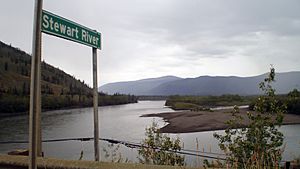Stewart River (Yukon) facts for kids
Quick facts for kids Stewart River |
|
|---|---|

The Stewart River seen from the Klondike Highway bridge
|
|
| Native name | Nä`chòo ndek |
| Country | Canada |
| Territory | Yukon |
| Cities |
|
| Physical characteristics | |
| Main source | Selwyn Mountains |
| River mouth | Yukon River 63°17′30″N 139°24′42″W / 63.29167°N 139.41167°W |
| Length | 533 km (331 mi) |
| Basin features | |
| Basin size | 51,000 km2 (20,000 sq mi) |
| Tributaries |
|
The Stewart River is a long river in the Yukon Territory of Canada. Its name in the Hän is Nä`chòo ndek. The river flows for about 533 kilometers (331 miles) and is a major branch of the Yukon River.
The Stewart River starts in the Selwyn Mountains. These mountains are found on the border between the Northwest Territories and the Yukon Territory. From there, the river flows west. It passes by the village of Mayo.
The Klondike Highway crosses the river at a place called Stewart Crossing. The highway then runs next to the river for about 56 kilometers (35 miles). After leaving the highway, the river turns southwest. It joins the Yukon River about 112 kilometers (70 miles) south of Dawson City. The small village of Stewart River is located where the Stewart River meets the Yukon River.
Contents
History of the Stewart River
Who discovered the Stewart River?
The Stewart River was explored by Robert Campbell in 1850. He worked for the Hudson's Bay Company. Campbell named the river after his good friend and helper, James Green Stewart. Stewart helped Campbell build and supply a trading post called Fort Selkirk. This fort was located where the Pelly and Yukon rivers meet.
How did the Klondike Gold Rush affect the river?
For many years, the Stewart River area was not developed. Then, the Klondike Gold Rush began. This event brought many people to the area looking for gold. The Stewart River was not as famous as the Klondike River for gold. Because of this, big mining companies did not pay much attention to it.
However, individual miners and smaller companies still searched for gold along the Stewart River. In 1914, a large amount of silver was found. This silver was discovered on a smaller river that flows into the Stewart. This discovery led to more mining in the area. In 1918, an even bigger silver source was found. This new discovery was at the place we now call Keno City.
How did mining change the Stewart River?
Mining for silver grew a lot in the Stewart River area. By 1923, the silver found there was worth more than all the gold from the Klondike. The Stewart River is not as deep as the Yukon River. This meant that regular steamboats could not travel on it. Special, shallower steamboats had to be built.
These special steamboats carried goods and people on the Stewart River. They were used until after World War II. After the war, new roads were built. These roads replaced the steamboats for transportation. One of these old steamboats, the S.S. Keno, is now a Canadian historic monument. You can see it in Dawson City.
Images for kids
See also
 In Spanish: Río Stewart para niños
In Spanish: Río Stewart para niños


